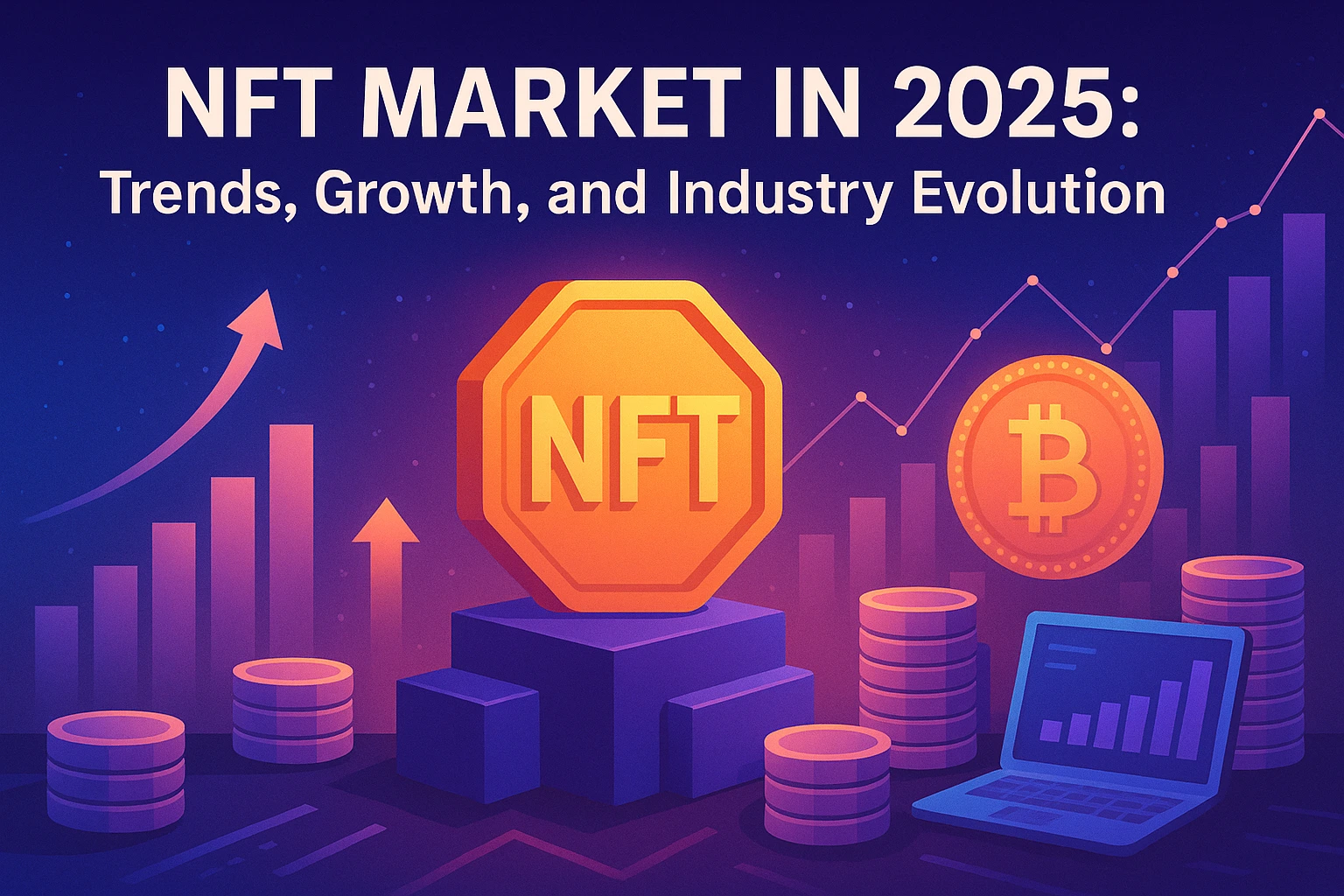Non-fungible tokens (NFTs), once seen as a speculative craze, are undergoing a major transformation in 2025. No longer limited to pixelated art and profile pictures, NFTs are now embedded into real-world applications—from real estate and education to entertainment and decentralized identity.
As regulatory frameworks mature, blockchain infrastructure improves, and brands continue to experiment with Web3 engagement models, the NFT landscape is becoming more functional, utility-focused, and sustainable.
This article explores the current state of the NFT market, the major trends shaping it in 2025, and how platforms like Ethereum, Solana, and Polkadot are enabling a more mature and interoperable NFT ecosystem.
The NFT Market in Numbers: Q2 2025 Overview
NFTs have rebounded from the market contraction of 2022–2023, and now demonstrate strong growth and diversification.
| Metric | Q2 2025 Value | YoY Growth |
| Total NFT Market Capitalization | $104 billion | +63% |
| Monthly Active NFT Wallets | 17.2 million | +47% |
| NFT Sales Volume (Monthly) | $7.9 billion | +52% |
| Top NFT Categories | Gaming, Identity, RWAs | N/A |
| Average NFT Transaction Fee | <$0.15 (Solana, L2s) | -60% vs 2023 |
What’s Driving NFT Growth in 2025?
NFTs are no longer just collectibles; they have evolved into programmable assets with real-world utility. Several key drivers fuel the market’s maturity in 2025:
1. Shift from Art to Utility
- NFTs represent digital diplomas, event tickets, loyalty credentials, and supply chain tokens.
- Enterprises tokenize certifications and KYC data for seamless cross-platform identity management.
2. NFT-Fi and Tokenized Assets
- Integration with DeFi protocols enables NFT lending, staking, and fractional ownership.
- Real-world assets (RWAs) like property deeds and invoices are minted as NFTs.
3. Cross-Chain Liquidity
- Platforms like Polkadot and Cosmos facilitate NFT transfers between blockchains.
- Ethereum L2s (Arbitrum, zkSync) reduce minting costs and speed up transactions.
4. On-Chain Metadata and Dynamic NFTs
- Smart contracts now update NFT metadata in real time based on events (e.g., game progress, identity reputation).
- “Evolving NFTs” reflect user activity and lifecycle value.
5. Mainstream Brand Adoption
- Starbucks, Nike, Sony, and Adidas launch NFT-powered loyalty programs.
- Hollywood and K-pop integrate NFTs into fan experiences and music rights.
Blockchain Ecosystem: Ethereum, Solana, Polkadot
Ethereum: Dominant But Scaling
- Remains the primary NFT ecosystem by volume and liquidity.
- Layer 2 networks like Arbitrum, Optimism, and zkSync power affordable NFT transactions.
- EIP-7521 standard improves metadata management and creator royalties.
Solana: Speed & Accessibility
- Popular for high-frequency NFT marketplaces and Web3 gaming.
- Offers sub-second transaction times and minimal gas fees.
- Major platforms: Magic Eden, Tensor, Solanart.
Polkadot: Interoperability Leader
- NFTs can move between parachains thanks to XCMP and XCM messaging.
- Enjin and Unique Network allow advanced programmability and cross-chain NFT logic.
- Ideal for ecosystem-wide loyalty and identity NFTs.
Emerging Use Cases in 2025
NFTs are penetrating sectors beyond art and collectibles. Here’s how:
1. Gaming & Metaverse
- NFTs represent in-game items, avatars, and access keys.
- Play-to-earn evolves into “play-and-own,” integrating NFTs with real-world assets.
- Examples: Illuvium, Big Time, Star Atlas.
2. Real Estate & RWAs
- Real estate NFTs linked to deeds and fractional ownership shares.
- Enables instant, verifiable transfer and trading of physical property rights.
3. Education & Employment
- Universities issue NFTs as tamper-proof diplomas.
- LinkedIn alternatives use NFT resumes verified on-chain.
4. Identity & Reputation
- Self-sovereign identities (SSI) now use NFTs to manage personal data and reputational scores.
- Integrated with decentralized voting and access management.
5. Enterprise & Supply Chains
- NFTs track product provenance and authenticity.
- Used in luxury goods, pharmaceuticals, agriculture.
NFT Monetization & Business Models
NFT creators and holders benefit from multiple monetization strategies:
- Royalties: Creators earn a share of every resale (programmable into smart contracts).
- Subscription NFTs: Grant holders ongoing content or service access (e.g., Mirror.xyz).
- Access NFTs: Unlock gated communities, events, or private DAOs.
- Revenue Sharing: Profit-sharing NFTs used in music, video streaming, and real estate.
- Ad-based Rewards: Watch-to-earn NFT models in adtech and creator economies.
Regulation & Standards in 2025
With NFT adoption spreading, regulation has also evolved.
Key Regulatory Milestones:
- EU MiCA: NFTs classified as digital assets; creators must disclose metadata.
- U.S. SEC Guidelines: Exempts “Utility NFTs” from securities law, mandates royalties disclosure.
- Japan & South Korea: NFT exchanges now require KYC/AML compliance.
- Brazil: NFT-linked land registries legalized under civil property law.
Standardization Advances:
- ERC-721R and ERC-1155U introduce improved royalty tracking and interoperability.
- DID (Decentralized Identity) standards ensure secure linking of NFTs to users.
Challenges & Security Risks
Despite the growth, challenges persist:
Main Issues:
- Scams and rug pulls via fake NFT projects or plagiarized content.
- Royalties evasion on secondary marketplaces.
- Storage risks for off-chain metadata (e.g., centralized IPFS gateways).
- Legal ambiguity for fractionalized NFTs (securities vs. collectibles).
Security Improvements:
- Decentralized storage (Arweave, Filecoin) for permanent metadata.
- AI-powered fraud detection for NFT mints and marketplace activity.
- Chainlink oracles verify NFT-backed asset existence.
Top NFT Platforms in 2025
| Platform | Focus | Blockchain | Monthly Users |
| OpenSea | General marketplace | Ethereum, Polygon | 2.3M |
| Magic Eden | Gaming, collectibles | Solana, ETH, Bitcoin | 1.5M |
| Blur | Pro trading | Ethereum | 1.2M |
| Rarible | Creator economy | Multichain | 980K |
| Mintbase | Utility NFTs | NEAR, ETH | 630K |
Outlook: NFT Predictions for Late 2025
- Dynamic Utility: NFTs with changing metadata tied to real-world data streams.
- AI-Generated NFTs: Artists and brands use generative AI to mint unique digital collectibles.
- Cross-Market Trading: Users seamlessly move NFTs between marketplaces via bridges.
- Embedded NFTs: In AR/VR glasses, smart TVs, and even IoT devices.
- Legal NFTs: Court documents, identity cards, and government licenses issued as NFTs.
FAQ
Are NFTs still just digital art?
No. NFTs now span real estate, credentials, gaming, supply chains, and digital identity.
What makes NFTs valuable in 2025?
Their utility, scarcity, programmability, and real-world integrations.
Can I create NFTs without coding?
Yes. Platforms like Rarible, Zora, and Mintbase offer no-code minting tools.
Are NFT royalties enforced in 2025?
Somewhat. Standards like ERC-721R are helping, but not all marketplaces support enforcement.
Are NFTs secure to use?
Generally yes, if created and traded on reputable platforms with verified smart contracts and decentralized storage.


